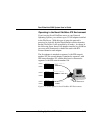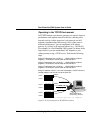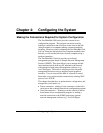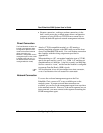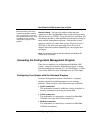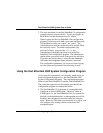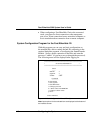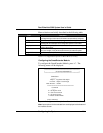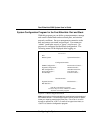
Fast EtherHub 3500 System User’s Guide
4-4 Configuring the System
Remote Connection
If you want to use a remote PC to configure either of the Fast
EtherHub-12mi models via modem connections, at the remote
site make sure the modem’s baud rate is 9600 and that the AT
command set is supported.
Configuring the Fast EtherHub Site
Connect your modem and PC
at the remote site. Dial into the
management agent, and remotely
configure the hub using the on-
board configuration program; or
directly attach to the network via
a SLIP connection and perform
configuration or management
functions using in-band network
management software.
Connect the hub’s DB9 serial port to the modem’s serial port
using standard serial cabling. (Refer to Appendix B for pin
assignments). For most modems, which use a 25-pin port, you
will have to provide an RS232 cable with a 9-pin connector on
one end and a 25-pin connection on the other end. You do not
have to set the modem communication parameters at the hub’s
site, because the hub will automatically configure it to auto-
answer mode. Just set it to force Data Set Ready (DSR) signals.
Configuring the Remote Site
At the remote site, connect the PC’s COM port (COM 1~4) to
the modem’s serial port. Set terminal emulation type to VT100,
specify the port used by your PC (i.e., COM 1~4), and then set
communications to 8 data bits, 1 stop bit, no parity, and 9600 bps.
Also be sure you set the flow control to “none.”
Remote Configuration Methods
Remote On-Board - If you establish a remote connection as
described in the previous section, you can use the on-board
management functions on the Fast EtherHub-12mi via a
terminal emulation program. See the section on
Using the Fast
EtherHub 3500 System Configuration Program
later in this chapter for
more information. However, note that the on-board
configuration functions only provide access to the hub’s private
MIB. To access the full range of SNMP management
functions, you must use optional network management software
(e.g., AccView/Open).





